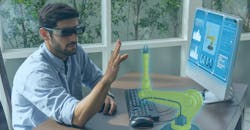Opening a Facility During Social Distancing Era
Innovation has always been a key component as manufacturers have worked to achieve competitive differentiation. Understandably, the digital journey intensified the need for innovation, in part because of digitalization’s ability to decimate global borders. The impact of COVID-19 has once again put an emphasis on innovation. Finding innovative ways of operating, and technologies such as augmented and virtual reality have emerged as effective solutions for ensuring the safety of employees, while keeping critical operations and workforce training in motion.
When Ericsson began operations at its new USA 5G Smart Factory in Texas, producing 5G base stations for the North American market, the factory’s engineering professionals were trained with very little face-to-face interaction.
Ericsson’s Head of People, Group Supply, Anna Cau tells IndustryWeek, being able to merge virtual and physical reality to provide effective hands-on training for complex smart factory operations has proved beneficial.
“We are not fully virtual in trainings for operations, but being able to offer virtual training sessions supported by VR and AR has increased our training efficiency and provided travel cost savings,” she says. “When faced with the challenge of onboarding employees in an ongoing construction environment and wanting to introduce them to a production environment them from day one, using VR technology was an obvious choice. With help of VR we could provide our employees essential live interactions with experts and virtually transfer them 8000 km to another Ericsson production site.”
By leveraging VR in the months prior to opening, new Ericsson employees were able to learn from peers in the company’s Tallinn, Estonia smart factory. To date, Cau’s team has been able to onboard more than 60 people. As a result, leveraging VR enabled Ericsson to staff and open the new complex within the target timeline and fully operational from day one – without the need for new U.S. factory employees to travel to other Ericsson locations for in-person onboarding.
According to Cau, one key learning, especially from the COVID-19 situation, is to have a flexible platform supporting usage of several devices, not only VR headsets but also tablets, smart phones, laptops etc. From a VR head-set perspective, Ericsson has embraced the importance of sanitary procedures such as providing replaceable faceplates as well as disinfecting faceplates after each use.
The creative use of technology is a key component of Ericsson’s goals with its new facility. Emerging technologies play an increasing larger role as industries adjust their processes and find new innovative ways of operating including connecting everything which can be connected, using 5G will open up the low latency use cases to support operation gains through the same investment, explains Cau.
“For our USA 5G Smart Factory, we can use technology such as machine learning and artificial intelligence to guide the production process for a more efficient and predictable production output, as well as to manage drones or other surveillance systems to avoid un-necessary costs to protect our assets by using the same investment/industrial IoT platform,” she says. “The palette of what can be put in action to support business will be endless using 5G.”
About the Author
Peter Fretty
Technology Editor
As a highly experienced journalist, Peter Fretty regularly covers advances in manufacturing, information technology, and software. He has written thousands of feature articles, cover stories, and white papers for an assortment of trade journals, business publications, and consumer magazines.
